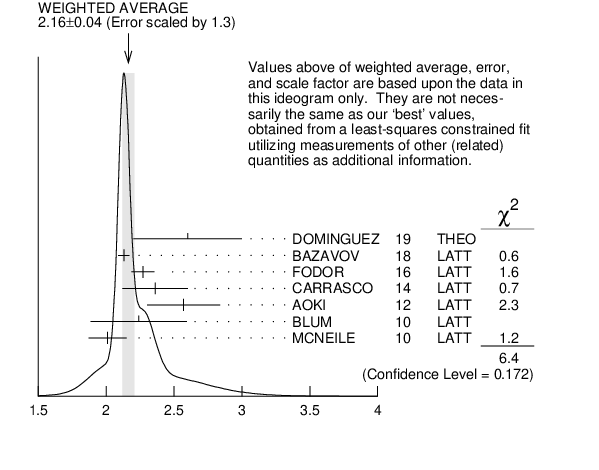${\mathit {\mathit u}}$-QUARK MASS
INSPIRE PDGID:Q123UM
The ${{\mathit u}}$-, ${{\mathit d}}$-, and ${{\mathit s}}$-quark masses are estimates of so-called “current-quark masses,” in a mass- independent subtraction scheme such as $\overline{\rm{}MS}$. The ratios ${\mathit m}_{{{\mathit u}}}/{\mathit m}_{{{\mathit d}}}$ and ${\mathit m}_{{{\mathit s}}}/{\mathit m}_{{{\mathit d}}}$ are extracted from pion and kaon masses using chiral symmetry. The estimates of ${{\mathit d}}$ and ${{\mathit u}}$ masses are not without controversy and remain under active investigation. Within the literature there are even suggestions that the ${{\mathit u}}~$quark could be essentially massless. The ${{\mathit s}}$-quark mass is estimated from SU(3) splittings in hadron masses.
We have normalized the $\overline{\rm{}MS}$ masses at a renormalization scale of $\mu $ = 2 GeV. Results quoted in the literature at $\mu $ = 1 GeV have been rescaled by dividing by $1.35$. The values of “Our Evaluation” were determined in part via Figures$~$2 and 3 in the “Quark masses” review.
We have normalized the $\overline{\rm{}MS}$ masses at a renormalization scale of $\mu $ = 2 GeV. Results quoted in the literature at $\mu $ = 1 GeV have been rescaled by dividing by $1.35$. The values of “Our Evaluation” were determined in part via Figures$~$2 and 3 in the “Quark masses” review.
|
||||||||||||||||||||||||||||||||||||||||||||||||||||||||||||||||||||||||||||||||||||||||||||||||||||||||||||||||||||||||||||||||||||||||||||||||||||||||||||||||||||||||||||||||||||||||||||||||||||||||||||||||||||||||||||||||||||||||||||||||||||||||||||||||||||||||||||||||||||||||||||||||||||||||||||||||||||||||||||||||||||||||||||||||||||||||||||||||||||||||||||||||||||||||||||||||||||||||||||||||||||||||||||||||||

${\mathit {\mathit u}}$-QUARK MASS (MeV) | ||||||||||||||||||||||||||||||||||||||||||||||||||||||||||||||||||||||||||||||||||||||||||||||||||||||||||||||||||||||||||||||||||||||||||||||||||||||||||||||||||||||||||||||||||||||||||||||||||||||||||||||||||||||||||||||||||||||||||||||||||||||||||||||||||||||||||||||||||||||||||||||||||||||||||||||||||||||||||||||||||||||||||||||||||||||||||||||||||||||||||||||||||||||||||||||||||||||||||||||||||||||||||||||||||
| References | ||||||||||||||||||||||||||||||||||||||||||||||||||||||||||||||||||||||||||||||||||||||||||||||||||||||||||||||||||||||||||||||||||||||||||||||||||||||||||||||||||||||||||||||||||||||||||||||||||||||||||||||||||||||||||||||||||||||||||||||||||||||||||||||||||||||||||||||||||||||||||||||||||||||||||||||||||||||||||||||||||||||||||||||||||||||||||||||||||||||||||||||||||||||||||||||||||||||||||||||||||||||||||||||||||
Except where otherwise noted, content of the 2024 Review of Particle Physics is licensed under a Creative Commons Attribution 4.0 International (CC BY 4.0) license. The publication of the Review of Particle Physics is supported by US DOE, MEXT (Japan), INFN (Italy) and CERN. Individual collaborators receive support for their PDG activities from their respective institutes or funding agencies. © 2024. See LBNL disclaimers.